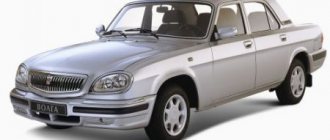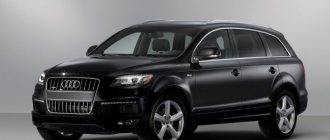Gelika consumption per 100 km diesel
Santa fuel consumption, excavator fuel consumption, average fuel consumption table, formula for gasoline consumption by kilometer, Pajero 4 3 0 fuel consumption
What is Gelik consumption per 100 km diesel
The effectiveness of Free Full is evidenced by the large number of clinical trials conducted on it, which were organized not only abroad, but also in our country. Any fuel is constantly subject to change due to the effects of temperature and humidity. This action causes the fuel to expand and contract. Ultimately, hydrocarbon molecules (the basis of any fuel) begin to attract each other, and thus form molecular groups - “clumps of molecules”.
Compound
formula for gas mileage
Pajero 4 3 0 fuel consumption
fuel consumption Toyota Surf 2 4 diesel
Audi A6 high gas mileage
Fuel consumption of the Mercedes G-Class ranges from 9.6 to 20.6 liters per 100 km. Mercedes-Benz G-Class is available with the following fuel types. Fuel consumption, l/100 km. Fuel used. 2.9 l, 330 hp, diesel, automatic transmission, all-wheel drive (4WD). 9.6. Diesel fuel. 2.9 l, 249 hp, diesel, automatic transmission, all-wheel drive. The gasoline version may have fuel consumption for 100 km. My friends persuaded me to buy a five-liter off-road Gelika. Real reviews of fuel consumption of Mercedes Benz Gelendwagen diesel per 100 km. Nikolay, Moscow. Mercedes Gelendvagen 3.0, 3.2, 4.0, 5.0, 5.5 petrol and diesel fuel consumption per 100 km. By kanistra Posted on 21/10/2019. The venerable Mercedes G-Class SUV has long become a legend. The real fuel consumption of Gelendvagen per 100 km is about 16-17 liters with measured driving and optimal speed. The site provides information on gasoline and diesel consumption for all popular and not so popular cars. Survey. What is the engine size of your car? I have driven 100 thousand km on the Gelika, now I will try to sell the car. In good condition, but there are problems with the body. Fuel consumption is 14 liters for the version with a 2.7-liter diesel engine producing 156 hp. The car is from 2004, with an automatic transmission. Visibility is excellent and the cabin is very spacious. During the week of testing, it flew 659 kilometers, which took 213 liters of 98th #ecto or 8,560 rubles and thus the average fuel consumption was 32.3 L / 100 KM. Consumption for active mode and heavy SUV. Fuel consumption of Mercedes Gelendvagen Mercedes Gelendvagen in detail about fuel consumption Car. Mercedes Gelendvagen diesel. Diesel engines that were installed on Mercedes. Official fuel consumption per 100 km. Generation 1 (W460, 1979-2009) 2.0, 109 l., manual, full. 2.3. Mercedes-Benz is a German automaker specializing in cars, trucks, buses and other vehicles. The company's head office is located in Stuttgart. The diesel SUV is equipped with permanent all-wheel drive with a low-range range and traction distribution between the axles in the proportion of 40% at the front and 60% at the rear (in normal conditions). And an important innovation in diesel engines is the active mounts of the internal combustion engine, which reduce the level of vibrations. At speeds below 5 km/h they. Now let's see what the real consumption of the new Jimny is in normal everyday trips. In the combined cycle when driving around the city and suburbs, the small SUV consumes no more than 6 l/100 km (16.6 km/l), which is quite comparable to crossovers that are less capable off asphalt. In conditions. fuel consumption of Mercedes Gelendvagen. How many liters does Gelik eat - petrol and diesel? If we take the new Gelendvagen, then the fuel consumption of the diesel version is 11.2 on average diesel fuel per 100 km, while the gasoline version will do. A friend of mine is planning to buy a Gelik, I would like to know the trail. questions: 1. How much gasoline does it consume per 100 kilometers? In general, a question about Gelendvagen! Dark Mc Pupil (28), closed 3 years ago. A friend of mine is planning to buy a Gelik, I would like to know the trail. questions: 1. How much gasoline does it consume? Acceleration from 0 to 100 km/h occurs in 5.50. Transmission. The indicators indicate how many liters of fuel (gasoline/diesel) a Mercedes-Benz car consumes per 100. Average fuel consumption is 12 l/100 km. When choosing #034;230th #034; pay attention to the injection system.
Test results
The FuelFree device is designed in such a way that the paired neodymium magnets that make up the Fuel Free act on the fuel. Moreover, these magnets create a powerful magnetic field, which crushes the links of hydrocarbon compounds, which is why the fuel burns faster. These clots cannot burn completely; some of them are in a zone inaccessible to oxygen. When fuel passes through the FuelFree installation area, the magnetic frequency resonance generated by the device disperses the resulting clumps into individual molecules, while positively charging them.
Expert opinion
The Powermag fuel activator has a very powerful magnetic field, which is important to consider during installation. It can affect the performance of electromagnetic devices, so it is extremely dangerous for people with pacemakers.
Fuel consumption of the Volkswagen Transporter ranges from 5.8 to 10.7 liters per 100 km. Modification. Fuel consumption, l/100 km. Fuel used. 2.0 l, 102 hp, diesel, manual transmission, front-wheel drive. 7.3. It is the Volkswagen Transporter with diesel fuel that remains the most popular in the secondary market. Such cars were rated at 60 and 68 hp. The average fuel consumption of the Volkswagen Transporter T4 diesel is 9.1 liters in the urban cycle, and on the highway the figures can be reduced to 7 liters. Volkswagen Transporter T5. Engine's type. Petrol. Diesel. 1.9 TDI 102hp Long Double Cab MT1.9 l., 102 l., Front-wheel drive. Volkswagen Transporter is a family of utility vehicles aimed at the mass consumer. This is the first minivan in the history of the German concern, which went into production in 1950. Volkswagen Transporter T4, T5 fuel consumption 1.9, 2.4, 2.5 diesel and gasoline. By kanistra Posted on 10/17/2015. Production of the Transporter model began in 1950. Then the minivan was produced under the name T1. Content. Volkswagen Transporter T4. Fuel consumption per 100 km Volkswagen Transporter T4. Reviews. I have a 1.9 liter diesel engine, the consumption is low - about 7 liters outside the city, in the city fully loaded - no more than 9. Volkswagen Transporter fuel consumption standards and actual data of Volkswagen Transporter owners. How to reduce fuel consumption - reviews from owners. Gasoline consumption and diesel consumption comparison table. Select the model and modification below: Modification. Recommended fuel. Fuel consumption Volkswagen T5 1.9 AHV. Fuel injection system, sensors, fuel tank, filters, pumps. I want to find out the real fuel consumption of a Volkswagen T5 with a 1.9 AHV engine. Anyone who has such an engine, please let me know your performance. I have: city 11-11.5l, highway 7.5-8l (speed.
Purpose
When you arrive at the airport, car rental shops are very easy to find in the terminal. Additionally, there are some low-cost companies located outside the airport that usually offer free shuttle service to connect their offices to the airport. You can save on taxis (which are expensive) and buses; Buses are very cheap, but can be quite an inconvenient option, especially if the bus stop is far from your hotel.
How to order?
Fill out the form for consultation and ordering Gelik consumption per 100 km diesel. The operator will clarify all the details with you and we will send your order. In 1-10 days you will receive the parcel and pay for it upon receipt.
Gelika consumption per 100 km diesel
. fuel consumption Toyota Surf 2 4 diesel. Reviews, instructions for use, composition and properties.
Ford Focus fuel consumption ranges from 3.4 to 10.7 liters per 100 km. Ford Focus is available with the following fuel types: Gasoline, Diesel fuel, Gasoline AI-95, Gas/petrol, Premium Gasoline (AI-98). Ford Focus is a compact city car produced since 1998. Since the mid-2000s, the model has occupied a leading position in sales among. Ford Focus engines. Official fuel consumption per 100 km. I am glad to welcome you, dear reader, to the pages of the blog. Today I present to your attention information on a current topic: Ford Focus fuel consumption. Moreover, in my article I will cover not one generation, but all three. ford focus2 sedan 100hp The automatic transmission has been running since January 2008. I bought it for myself in March 2012. The consumption (at 92nd) was around the city. I decided to check the consumption without relying on the computer; at the minimum fuel mark I decided to fill in 500 rubles worth of gasoline. The consumption was 10.7 liters per 100 km. taking into account warming up. Help me reduce it. The graphs show the fuel consumption of a Ford Focus II in three modes: in the city, on the highway and in mixed mode. Consumption data for all known modifications is shown. For those modifications for which there is information about all three modes, a general graph with an average value is constructed. The instrument panel displays the on-board computer readings. You can go to this menu item by pressing the SET key several times. Consumption rates. It is important to remember that the car does not display the current parameters, but the average values, starting with the most recent one. Review from the owner of Ford Focus I Hatchback - observation. Ford Focus Hatchback Ghia › Logbook › #11 Ford Focus engines. Official fuel consumption per 100 km. First appearing on the market in 1999, the Ford Focus has won an army of fans all over the world. This car is versatile, offered in several body styles, reliable and comfortable. Basic fuel consumption of a Ford Focus. Find out what the specific fuel consumption of your car's engine is. Ford Focus fuel consumption. Year. Modification. Recommended fuel. Consumption in the city. Ford Focus: fuel consumption per 100 km, basic standards and reviews. Ford is a car worth choosing. But in the conditions of modern fuel economy, it will be interesting to know what fuel consumption the Ford Focus has.
Mercedes-Benz Sprinter
Mercedes Sprinter belongs to the family of small cars. The model has several body length options, several wheelbase modifications, as well as three roof height options. In addition, the Sprinter can be equipped with dual or single wheels on the rear axle.
Due to this abundance, the Sprinter can be used as a passenger minibus, minibus, cargo van, flatbed truck, specialized vehicle and many other options.
| Engine | Consumption (city) | Consumption (highway) | Flow (mixed) | Fuel type |
| 1.8 NGT 6-mech, 2WD | 16,5 | 9,7 | 12,2 | Petrol |
| 1.8NGT NAG W5A | 14,5 | 9,5 | 11,4 | |
| 2.1 CDi 6-mech, 2WD | 8,9 | 6,2 | 7,2 | Diesel |
| 2.1 CDi 6-mech, 4x4 | 9,5 | 6,7 | 7,7 | |
| 2.1 CDi NAG W5A, 4x4 | 9,7 | 7,4 | 8,7 | |
| 2.1 CDi 7G-Tronic | 7,9 | 6,3 | 6,9 | |
| 2.2 CDi 6-mech, 2WD | 8,9 | 6,2 | 7,2 | |
| 2.2 CDi 6-mech, 4x4 | 9,8 | 7 | 8 | |
| 2.2 CDi NAG W5A | 10,6 | 7,7 | 8,5 | |
| 2.2 CDi 7G-Tronic Plus | 7,6 | 6,4 | 6,9 | |
| 3.0 CDi 6-mech | 12,2 | 7,7 | 9,4 | Petrol |
| 3.0 CDi NAG W5A, 2WD | 11,1 | 7,5 | 8,8 | |
| 3.0 CDi NAG W5A, 4x4 | 11,7 | 8,1 | 9,4 |
Customer reviews:
The effectiveness of Free Full is evidenced by the large number of clinical trials conducted on it, which were organized not only abroad, but also in our country.
I ordered FreeFuel in the hope that I would save at least a little on fuel, the Economy met my expectations, I have been using it for more than three months, I am satisfied
From the information above, we conclude that you should not chase after new electronic devices if you are not sure that you are buying an original device. This particular device really works, but the owners of gas stations and oil refineries actively prevent the dissemination of information about FUEL FREE at the highest level. Fortunately, my site hasn’t been blocked yet. Use the information!
Fuel consumption on a Mercedes-benz Gelendwagen
This brand of car is known to almost everyone. It is difficult not to recognize it on the roads; it amazes with its power and original body. This SUV has excellent cross-country ability, dynamics, and is also reliable and safe. The car was first released in the 70s; nowadays the third generation of Mercedes Gelendvagen in the W463 body is being produced. It can be equipped with either automatic or manual transmission. Developers always listen to the opinions of owners and the wishes of potential buyers. Therefore, there are many body versions to suit any customer preferences. As for engines, gasoline engines have from 4 to 8 cylinders, and their volume is: for four cylinders - 2.3 l, six - 3.0 l, eight - 5.0 and 5.5 l. The amount of horsepower under the hood is amazing – from 124 to 386 hp.
Fuel consumption rate according to reviews
Alexey, Novgorod. I purchased a used car from 2002. The engine is 3.2 liters and runs on petrol. Automatic transmission, all-wheel drive. I always wanted a purely German car, the price really bites. Easily reaches 110-150 km/h. Consumes about 13 liters per hundred, at good speed on the highway. In the city, traffic jams can consume up to 18 liters of gasoline.
Maxim, Urengoy. I have always dreamed of driving a Gelendvagen and recently I made my dream come true. I took a unit with a 5.0 liter engine from 2009, with an automatic transmission. Now I think it would be better to buy a diesel engine. If you ride on the highway, it takes 20.0 per 100 km, if traffic is difficult, then all 25 liters. Fuel costs take a significant toll on your wallet.
Victor, Moscow. The car is beautiful and powerful, but in a big city this is a dubious advantage. Such a “beast” has to be refueled very often. I took a 2009 Gelika with a 3.0 liter engine and a manual transmission, while on the highway it consumes almost 18 liters of gasoline. I always refuel AI-98.
Stanislav, Saratov. Gelik is an excellent option for any off-road. But you need to be prepared to shell out a lot of money to refuel such a car. If you drive on the highway, it’s basically tolerable – 13 liters per hundred km. But in the city and on rough terrain, it pumps out 19 liters.
Mercedes-benz gelendwagen on gasoline
The first generation of Gelendvagen has the following types of gasoline and diesel engines:
- engine volume 2.3 l – fuel consumption per 100 km up to 12 l;
- volume 2.8 l – fuel consumption per hundred – up to 17 l;
- 2.4 l diesel engine – up to 11 l;
The second generation produces the following consumption indicators:
- 3.0 liter – 9-13 l/100km;
- volume 5.5 – 12-21 l/100 km.
Actual figures may vary depending on related factors:
- driving style;
- terrain - city or highway;
- Gelendvagen mileage;
- general condition of the car;
- fuel quality;
Mercedes-Benz W124
Under the Mercedes W 124 symbol, a whole series of cars belonging to the business class was produced. The models were produced from 1984 to 1996.
The W124 replaced the outdated W 123. With the advent of 1995, sedan models gave up pride of place to the new generation of E-class cars with the W 210 index. At the same time, cars in the station wagon version were still produced in German factories until April 1996.
| Engine | Consumption (city) | Consumption (highway) | Flow (mixed) | Fuel type |
| 2.0 MT 75 hp (Mechanics) | 7,9 | 5,3 | 6,7 | Diesel |
| 2.0 MT 105 hp (Mechanics) | 11,4 | 7 | 9,1 | Petrol |
| 2.0 MT 123 hp (Mechanics) | 11,4 | 7 | 9,1 | |
| 2.0 MT 136 hp (Mechanics) | 11,3 | 6,6 | 8,6 | |
| 2.2 MT 150 hp (Mechanics) | 11,7 | 6,6 | 8,8 | |
| 2.3 MT 132 hp (Mechanics) | 11,4 | 7,2 | 9,2 | |
| 2.5 MT 95 hp (Mechanics) | 8,9 | 5,4 | 7,1 | Diesel |
| 2.5 MT 113 hp (Mechanics) | 8,9 | 5,4 | 7,1 | |
| 2.6 MT 158 hp (Mechanics) | 14,6 | 7,9 | 10,7 | Petrol |
| 2.6 MT 163 hp (Mechanics) | 14,5 | 8 | 10,1 | |
| 2.8 MT 193 hp (Mechanics) | 14,6 | 7,9 | 10,7 | |
| 3.0 MT 136 hp (Mechanics) | 9,1 | 5,5 | 7,4 | Diesel |
| 3.0 AT 150 hp (machine) | 9,3 | 5,6 | 7,9 | |
| 3.0 MT 177 hp (Mechanics) | 15,2 | 8,2 | 11,1 | Petrol |
| 3.0 AT 180 hp (machine) | 14,6 | 8,1 | 11,3 | |
| 3.0 MT 185 hp (Mechanics) | 14,6 | 8 | 10,9 | |
| 3.0 MT 234 hp (Mechanics) | 14,8 | 8,1 | 11 | |
| 3.2 MT 220 hp (Mechanics) | 14,8 | 8,1 | 11 | |
| 4.2 AT 279 hp (machine) | 15 | 9,4 | 11,8 | |
| 5.0 AT 320 hp (machine) | 16,8 | 13,8 | 14,9 |
Gasoline consumption according to passport
The Mercedes SUV has been produced since 1979. Over time, the engine size and fuel used changed, and therefore the fuel consumption rate changed. The manufacturer provides the following figures for gasoline consumption by a G-Class Gelendvagen car per 100 kilometers:
| Gearbox, drive | Mercedes-Benz G-Class 2nd rest. 1998 | |||
| automatic, PP | 5.0; 296 hp | Mercedes-Benz G-Class 3rd rest.2002, suv, 2nd generation | ||
| automatic, PP | 5.4; 476 hp | 5.0; 296 hp | Mercedes-Benz G-Class 4th rest. 2006 | |
| automatic, PP | 5.0; 296 hp | Mercedes-Benz G-Class 5th rest. 2008 | ||
| automatic, PP | 5.4; 507 hp | Mercedes-Benz G-Class 6th rest.2012 | ||
| automatic, PP | 6.0; 612 hp | Mercedes-Benz G-Class 7th rest.2015 | ||
| automatic, PP | 5.5; 571 hp | 4.0; 422 hp | 6.0; 630 hp | Mercedes-Benz G-Class 2021 |
| automatic, PP | 4.0; 585 hp |
Dry fuel consumption according to passport
It is known that an engine that uses diesel as fuel has gained its popularity due to its economical fuel consumption. During the tests, the Mercedes manufacturer obtained the following values for diesel consumption:
Gearbox, drive
Mercedes-Benz G-Class 2nd res. 1998 automatic transmission, PP Mercedes-Benz G-Class 3rd rest. 2002 automatic, PP4.0; 250 hpMercedes-Benz G-Class 5th rest. 2008 automatic machine, PP5.4; 507 hpMercedes-Benz G-Class 6th rest. 2012 automatic transmission, all-wheel driveMercedes-Benz G-Class 7th rest. 2015 automatic transmission, PP Mercedes-Benz G-Class 2021 automatic transmission, PP2.9; 249 hpMercedes-Benz Vito
The first Mercedes Vito rolled off the assembly line in 1995 at the company's plant in Spain. Four years later, the minibus was modified both in terms of interior and appearance. For example, the radiator grille, side skirts and roof rails were modified, as well as the bumpers and door handles, which from that moment began to be painted in body color. The range of engines was also not ignored. In addition, the Vito has increased the equipment package available upon special order.
| Engine | Consumption (city) | Consumption (highway) | Flow (mixed) | Fuel type |
| 2.0 AT 129 hp (machine) | 12 | 9 | 10,4 | Petrol |
| 2.2 AT 163 hp (machine) | 8,7 | 6,3 | 7,1 | Diesel |
| 2.3 AT 198 hp (machine) | 12,1 | 6,8 | 8,8 |
I can afford: used SUVs that everyone can afford
Mercedes-Benz G-class
The terrible word Geländewagen actually means just “off-road vehicle”, and it was developed in the 70s in collaboration with the Austrian company Steyr-Puch. We owe the appearance of the “gangster icon” to the Iranian Shah Mohammad Reza Pahlavi, who was one of the owners of the Daimler company - it was he who ordered the angular frame all-terrain vehicle for his defense needs. The first civilian version went on sale in 1979.
When the G-Wagen was significantly updated in 1989, it acquired the image of a premium SUV that is familiar today, receiving a range of powerful engines, ABS, leather seats, wood trim and other attributes of a well-fed life. This version (W463 body) with various modifications lives on the assembly line to this day.
In Russia, such cars were bought by the powerful - security forces, crime bosses and very serious businessmen. The cars were used harshly, although they have a very solid margin of safety.
Average prices
Our price range includes cars of the very first iteration of the W463, as well as after the 1997 restyling. Cars of the updated 2000 version priced below a million are already very difficult to find.
By the way, in 2000 a G-class cost 90-100 thousand dollars. Taking into account the then dollar exchange rate of 28 rubles – from 2.5 to 2.8 million rubles. Mercedes, as you know, fall in price slowly, and Gelikas even more slowly, and, nevertheless, in 14 years the car began to cost almost three times less. However, we should not forget about inflation and the appreciation of the dollar. For example, a new Mercedes G-class today costs from 4.4 million rubles.
1996617 000 RUR 1997640 000 RUR 1998771 000 RUR 1999824 000 RUR 2000891 000 RURFuel consumption and transport tax
Gasoline Gelendvagens are obscenely gluttonous. In the late 90s, with gasoline prices at that time, this did not bother anyone, but now it can hurt your pocket. You won’t find cars with a weak 2.7-liter diesel engine on the secondary market, but there are quite a lot of them with a 3-liter diesel engine.
| Model | Engine | Fuel consumption in the urban cycle per 100 km and octane number | Transport tax for the year in Moscow |
| G270 CDI | 2.7 l, diesel, 156 hp | 13.7 l | 7,020 rub. |
| G300 TD | 3.0 l, diesel, 177 hp | 14.6 l | RUB 8,850 |
| G320 | 3.2 l, gasoline, 215 hp. | 19.8 l, AI-95 | RUB 13,975 |
| G400 CDI | 4.0 l, diesel, 250 hp | 16.1 l | RUB 18,075 |
| G500 GE | 5.0 l, gasoline, 241 hp | No data, AI-95 | RUB 18,750 |
| G500 | 5.0 l, gasoline, 296 hp. | 21.8 l, AI-95 | RUB 44,400 |
For example
If you decide not to save and purchased a Gelik with a powerful 5.0 liter engine, then with an annual mileage of 15,000 kilometers, get ready to spend 110-120 thousand rubles on gasoline, or about 10 thousand per month. Do you like to travel always and everywhere? Double the amount.
What if it breaks?
In general, the Gelendvagen is an extremely reliable car. If handled correctly, the engine and automatic transmission can last several hundred thousand kilometers without any problems. Mainly the suspension suffers, or rather the rear springs. They cost quite reasonable money - about 2 thousand rubles apiece. Also, over the years, the body—door hinges and wheel arches—corrodes. Replacing the interior heater motor on a pre-restyling Gelika cabin can be an expensive pleasure. To perform the operation, a complete disassembly of the dashboard and an amount of 10 thousand rubles are required.
Ivanov Oleg , General Director of STO "Position 2000"
Range Rover Sport
The Range Rover Sport was born three years after the release of the “regular” Range Rover to “keep up” with the BMW X5 and Mercedes-Benz M-class. Keep up - in the literal sense of the word. The Range Rover, although luxurious, was too heavy and clumsy.
The recipe for creating a lightweight version was as follows: a body from the “older” RR with pillars piled up for a swift silhouette at the front and rear, plus a shorter base and a frame chassis from the Discovery 3. The resulting car was lighter and sportier, and could also be considered a full-fledged SUV. True, there was no significant gain in dynamics - even with a top-end 390-horsepower turbo engine, the car reached the second “hundred” in 7.6 seconds, which is not so fast by the standards of premium SUVs.
But, unlike the purely asphalt “Germans,” the Range Rover Sport could afford a lot off-road and was cheaper than the “big” RR. Which, in fact, predetermined its popularity.
Average prices
In 2005, the price for the most modest Range Rover Sport trim was $82,900. The top one is almost 30 thousand more expensive - 111,640. Taking into account the dollar exchange rate at 28 rubles - from 2.3 to 3.1 million rubles. Our scope includes only cars produced before the 2009 restyling.
Due to their dubious reliability, British cars are falling in price very quickly, and for the money that a 2006 Sport now costs, you can only find a Gelendvagen from 1998. Today, the new generation Range Rover Sport in the initial configuration costs almost the same as the top-end 2005 model - 3.1 million rubles.
| Year of issue | average price |
| 2005 | 712,000 rub. |
| 2006 | 791,000 rub. |
| 2007 | 872,000 rub. |
| 2008 | RUB 1,027,000 |
Fuel consumption and transport tax
Since gasoline engines, both naturally aspirated and supercharged, consume an indecent amount of gasoline even compared to competitors, diesel modifications of the Range Rover Sport were more readily accepted. The most popular option is with a 3.6-liter diesel engine, although from the point of view of the tax burden, the most modest 2.7-liter is preferable.
| Model | Engine | Fuel consumption in the urban cycle per 100 km and octane number | Transport tax for the year in Moscow |
| H.S.E. | 2.7 l, diesel, 195 hp | 12.7 l | RUB 9,750 |
| HSE/Limited Edition | 3.6 l, diesel, 272 hp | 14.7 l | 40,800 rub. |
| HSE/SE | 4.4 l, gasoline, 299 hp. | 20.8 l, AI-95 | RUB 44,850 |
| S/C | 4.2 l, gasoline, 390 hp. | 22.4 l, AI-95 | RUB 58,500 |
For example
A top-end English SUV with a herd of 390 horses and an annual mileage of 15 thousand kilometers will require gasoline costs in the region of 110-115 thousand rubles. It is not difficult to calculate that you will have to spend about 10 thousand monthly.
What if it breaks?
Range Rover Sport was often repaired under warranty - there were many manufacturing defects. For example, the automatic transmission of a car failed up to 100 thousand kilometers. In the event of a breakdown, repairing the gearbox will cost 70-100 thousand rubles. The car also has problems with steering rods, replacement of which costs 500 rubles, plus 2 thousand for parts on each side. Replacing the steering rack is estimated at 4.5 thousand rubles, plus about 20 thousand for the part. Diesel units may have a problem with the injection pump, which will cost about 35 thousand rubles.
Vladislav, electrician-diagnostician at Lord Rover service station
Toyota Land Cruiser
The car debuted in 1997, and officially reached Russia at the end of 1998 and soon became the best-selling SUV in the country. The epic Toyota quality and unpretentiousness, combined with a more or less affordable price (compared to competitors) predetermined the fate of the Kukuruzer.
This car was highly valued by provincial officials. Toyota is considered a mass brand, which means that owning such a car is not a luxury, and therefore management will not condemn it. The car was also “tested” by criminal figures, security agencies, middle-class businessmen, wealthy Siberian oil workers and... car thieves. The Land Cruiser 100 was very easy to burglarize, and therefore such cars were stolen en masse. It is worth considering that the secondary market is full of copies with a “foggy” past, which may raise questions during registration.
Average prices
In 2002, the updated Land Cruiser cost 55-65 thousand dollars. If we take the then dollar exchange rate of 31 rubles as a basis, it would be from 1.7 to 2.0 million rubles. Toyota is falling in price very slowly, and now it costs less than Gelendvagen only because it was initially more affordable. Today, the Land Cruiser has retained its popularity, but has ceased to be the “people’s” premium - the price starts from 3 million rubles.
| Year of issue | average price |
| 1998 | 705,000 rub. |
| 1999 | 720,000 rub. |
| 2000 | 754,000 rub. |
| 2001 | 798,000 rub. |
| 2002 | 870,000 rub. |
| 2003 | 960,000 rub. |
| 2004 | RUB 1,046,000 |
Fuel consumption and transport tax
The Japanese traditionally do not accept supercharged engines and remain faithful to atmospheric classics, so from a tax point of view, Land Cruiser is inexpensive to maintain. The same cannot be said about fuel, which gasoline units need a lot of, despite the far from record output. There are two top-end engines most often found on the market: a 4.2 liter diesel engine with a power of 204 hp actively competes with a 4.7 liter petrol unit.
Mercedes Gelendvagen 3.0, 3.2, 4.0, 5.0, 5.5 petrol and diesel fuel consumption per 100 km
The venerable Mercedes G-Class SUV has long become a legend. This monster was first shown to the public back in 1979 in France. Until today, the demand for the American-German product has not fallen, which means that the company is not going to curtail production, periodically updating Gelandewagen. At the moment, in addition to the classic version, it is possible to buy a convertible. The assembly of such SUVs is carried out exclusively in Austria, and the famous tuning studio AMG works with the G-Class, which indicates the exclusivity of the “all-terrain vehicle”.
Mercedes-Benz G 3.0, 3.2, 4.0, 5.0, 5.5 - petrol
The second generation of all-wheel drive Gelandewagen was offered to Europeans in 1994. At that time, the SUV was still actively purchased by the armies of many countries. The options include a body with 2, 3 and 5 doors. The new Gelendvagen is almost unique because of its three fully lockable differentials. Transmissions include 5, 6 and 7-speed automatic depending on the year of manufacture, as well as manual transmission. Depending on the volume, Gelandewagen takes the first hundred in 7.3-18.4 seconds. Maximum acceleration up to 197 km/h. Fuel consumption: in urban conditions 14.5-21.8 l, on the highway 11.0-13.7, average - up to 17.8.
Mercedes-Benz Gelandewagen
The official date of appearance of the first Gelendvagen is considered to be February 10, 1979. It was on this day that the public presentation of the model took place and mass production began. However, 1979 can only be called a conditional date, since the history of the G-class begins many years earlier.
Few people know that the first Gelandewagen was released back in 1926, when the experimental Mercedes Benz G1 model rolled off the company’s assembly line. This car was equipped with an additional rear axle, which was intended to increase off-road capability.
| Engine | Consumption (city) | Consumption (highway) | Flow (mixed) | Fuel type |
| 3.0 AT 184 hp (machine) | 14,6 | 9,9 | 11,7 | Diesel |
| 3.0 AT 211 hp (machine) | 13,8 | 9,8 | 11,2 | |
| 5.5AT 520 hp (machine) | 19,6 | 11,8 | 14,7 | Petrol |
| 5.5AT 536 hp (machine) | 17,2 | 11,8 | 13,8 | |
| 6.0AT 603 hp (machine) | 22,6 | 13,7 | 17 |











